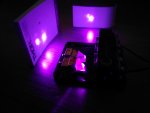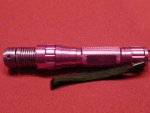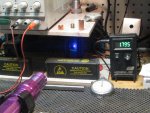
Welcome to Laser Pointer Forums - discuss green laser pointers, blue laser pointers, and all types of lasers
How to Register on LPF | LPF Donations
Navigation
Install the app
How to install the app on iOS
Follow along with the video below to see how to install our site as a web app on your home screen.
Note: This feature may not be available in some browsers.
More options

You are using an out of date browser. It may not display this or other websites correctly.
You should upgrade or use an alternative browser.
You should upgrade or use an alternative browser.
Sharp GH04W10A2GC 350mW 405nm
- Thread starter DTR
- Start date


- Joined
- May 12, 2017
- Messages
- 961
- Points
- 93
I used 5500bu driver from xwossee,
Time will answer,it will die after few hours,but i want know you test(Rich and RCB)
How long it will die if you run at 1A and 1,5A
Time will answer,it will die after few hours,but i want know you test(Rich and RCB)
How long it will die if you run at 1A and 1,5A
- Joined
- Dec 15, 2014
- Messages
- 6,773
- Points
- 113
Hi Red
I have 2 more of them buck/boosts left. I will try one out in a flash light mod copper sink
The only thing I don’t like is that you have to sink the entire bottom. Need a sink with a shelf or a large pill
I have 2 more of them buck/boosts left. I will try one out in a flash light mod copper sink
The only thing I don’t like is that you have to sink the entire bottom. Need a sink with a shelf or a large pill
wolfram
0
- Joined
- Sep 13, 2008
- Messages
- 522
- Points
- 43
hi LT17, how long have you run the diode at the given output? I had one at 1.1 A on a nano and it LED'd after a couple of hours and then died!!!!
- Joined
- Dec 15, 2014
- Messages
- 6,773
- Points
- 113
Hi Wolf,
I tested a diode from my batch set to 1.5A for at least 5 Minutes. Going to try one in a host with a Boost/Buck X Wossee . Or I can use a Flex Drive V5 with all the resistors bridged to get 1.5A . The X Wosse driver set to a max of 1.5A
Hope this helps you out.
Rich
I tested a diode from my batch set to 1.5A for at least 5 Minutes. Going to try one in a host with a Boost/Buck X Wossee . Or I can use a Flex Drive V5 with all the resistors bridged to get 1.5A . The X Wosse driver set to a max of 1.5A
Hope this helps you out.
Rich
wolfram
0
- Joined
- Sep 13, 2008
- Messages
- 522
- Points
- 43
Good Luck
- Joined
- Feb 12, 2016
- Messages
- 589
- Points
- 63
Funny, I have been trying to knife-edge 4 of these diodes since many months already. And I still started from ones Hakzaw extracted for me from junktronics modules. Thank you Hak!
Finally I had to buy 6 of them to select 4 with good output (one was dead and one too weak)... made a setup in Lasertack micro mount with 3mm offset which I originally thought to use for single mode SO6J diodes.
Now the unexpected problem I face is that Lasertack prism mirrors which I have been using for NUBM44 for many years look to let this WL to pass (1st mirror on picture). Not all of them but a half of mirrors for sure. Alex from LT said that the coating may be sensitive to polarisation. Soon he will send me the ones specified for 405nm only and I hope to be able to finish this build.
In between these Sharp diodes appeared at techhood shop, now at DTR's and became much cheaper and easy to get than at the time I started...!

Finally I had to buy 6 of them to select 4 with good output (one was dead and one too weak)... made a setup in Lasertack micro mount with 3mm offset which I originally thought to use for single mode SO6J diodes.
Now the unexpected problem I face is that Lasertack prism mirrors which I have been using for NUBM44 for many years look to let this WL to pass (1st mirror on picture). Not all of them but a half of mirrors for sure. Alex from LT said that the coating may be sensitive to polarisation. Soon he will send me the ones specified for 405nm only and I hope to be able to finish this build.
In between these Sharp diodes appeared at techhood shop, now at DTR's and became much cheaper and easy to get than at the time I started...!


- Joined
- Jun 24, 2010
- Messages
- 5,704
- Points
- 113
Sent out quite a few so far with 700mA ACS1500SE's. So far have not had any reports of failures yet but it is still early. Hopefully that holds and if it does given time will bump up a bit and give it some time to generate any failure data.
I do sell to a pretty wide range of customers and the ones I get the best info from are the engraving and light show guys(although light shows have been a little less busy these days. This is not a unit that would be in much demand for that.
Good to know that some are seeing failures over 1A and yes the drivers used are important. As the nano which Lazeerer specifically designed to deal with the crazy random death issue that was happening at most any current with switching drivers out at the time. Linear drivers were not having the same issues which is how we knew it had to the the drivers but linear drivers just were not practical in handhelds due to common battery configurations, forward voltage and voltage drop in the regulator. As well as thermal management needs being increased.
He spent months trying to design it and had the advantage of knowing and getting some feedback/insight from some of the engineers he knew that work in the industry. Never really explained what the key was but if I remember without having to go back though my messages due to sensitivity of frequency or something that was a byproduct of the way switching drivers chop and recombine the incoming voltage/current(don't pretend to understand the specifics as not my wheelhouse). Anyway when delivered I went from seeing a 1/3 failure rate at just about any current over 200mA to a near zero rate when he delivered the new drivers up to 600mA. Now it may have been the saving grace to that diode but it may not be the nicest to play with this diode specially when pushing so far past the designed parameters.
I will update with any reports as I generate some reliability data. It would be good to see even if it just an estimate the amount of time being powered on not just how long since the unit was built specially if coming from an application like a handheld. With these seeing an hour or two on a unit of actual working time I would say is very rare. Keeping in mind these diodes are designed for applications that can rely on 500-30,000 hours of continuous use. I worry there gets to be some crossover confusion when say some are trying to figure out if a diode will be reliable in a more use heavy application.
I will say the more I use these the more they are growing on me. I was pretty resistant to them for years since they were not single mode and you do give up some power density but I now have to admit they have their appeal. I now really no longer think of these as comparable to the single mode near UV diodes. Other than similar in wavelength they are quite different. Anyway I actually feel kind of bad and sorry as due to my resistance to bribing these into the spotlight I might have somewhat deprived the community really experiencing them since I have had access to them for at least two years and only actually got one in my hands due to a mistake.
I do sell to a pretty wide range of customers and the ones I get the best info from are the engraving and light show guys(although light shows have been a little less busy these days. This is not a unit that would be in much demand for that.
Good to know that some are seeing failures over 1A and yes the drivers used are important. As the nano which Lazeerer specifically designed to deal with the crazy random death issue that was happening at most any current with switching drivers out at the time. Linear drivers were not having the same issues which is how we knew it had to the the drivers but linear drivers just were not practical in handhelds due to common battery configurations, forward voltage and voltage drop in the regulator. As well as thermal management needs being increased.
He spent months trying to design it and had the advantage of knowing and getting some feedback/insight from some of the engineers he knew that work in the industry. Never really explained what the key was but if I remember without having to go back though my messages due to sensitivity of frequency or something that was a byproduct of the way switching drivers chop and recombine the incoming voltage/current(don't pretend to understand the specifics as not my wheelhouse). Anyway when delivered I went from seeing a 1/3 failure rate at just about any current over 200mA to a near zero rate when he delivered the new drivers up to 600mA. Now it may have been the saving grace to that diode but it may not be the nicest to play with this diode specially when pushing so far past the designed parameters.
I will update with any reports as I generate some reliability data. It would be good to see even if it just an estimate the amount of time being powered on not just how long since the unit was built specially if coming from an application like a handheld. With these seeing an hour or two on a unit of actual working time I would say is very rare. Keeping in mind these diodes are designed for applications that can rely on 500-30,000 hours of continuous use. I worry there gets to be some crossover confusion when say some are trying to figure out if a diode will be reliable in a more use heavy application.
I will say the more I use these the more they are growing on me. I was pretty resistant to them for years since they were not single mode and you do give up some power density but I now have to admit they have their appeal. I now really no longer think of these as comparable to the single mode near UV diodes. Other than similar in wavelength they are quite different. Anyway I actually feel kind of bad and sorry as due to my resistance to bribing these into the spotlight I might have somewhat deprived the community really experiencing them since I have had access to them for at least two years and only actually got one in my hands due to a mistake.
Last edited:
- Joined
- Jun 14, 2017
- Messages
- 452
- Points
- 63
Sent out quite a few so far with 700mA ACS1500SE's. So far have not had any reports of failures yet but it is still early. Hopefully that holds and if it does given time will bump up a bit and give it some time to generate any failure data.
I do sell to a pretty wide range of customers and the ones I get the best info from are the engraving and light show guys(although light shows have been a little less busy these days. This is not a unit that would be in much demand for that.
Good to know that some are seeing failures over 1A and yes the drivers used are important. As the nano which Lazeerer specifically designed to deal with the crazy random death issue that was happening at most any current with switching drivers out at the time. Linear drivers were not having the same issues which is how we knew it had to the the drivers but linear drivers just were not practical in handhelds due to common battery configurations, forward voltage and voltage drop in the regulator. As well as thermal management needs being increased.
He spent months trying to design it and had the advantage of knowing and getting some feedback/insight from some of the engineers he knew that work in the industry. Never really explained what the key was but if I remember without having to go back though my messages due to sensitivity of frequency or something that was a byproduct of the way switching drivers chop and recombine the incoming voltage/current(don't pretend to understand the specifics as not my wheelhouse). Anyway when delivered I went from seeing a 1/3 failure rate at just about any current over 200mA to a near zero rate when he delivered the new drivers up to 600mA. Now it may have been the saving grace to that diode but it may not be the nicest to play with this diode specially when pushing so far past the designed parameters.
I will update with any reports as I generate some reliability data. It would be good to see even if it just an estimate the amount of time being powered on not just how long since the unit was built specially if coming from an application like a handheld. With these seeing an hour or two on a unit of actual working time I would say is very rare. Keeping in mind these diodes are designed for applications that can rely on 500-30,000 hours of continuous use. I worry there gets to be some crossover confusion when say some are trying to figure out if a diode will be reliable in a more use heavy application.
I will say the more I use these the more they are growing on me. I was pretty resistant to them for years since they were not single mode and you do give up some power density but I now have to admit they have their appeal. I now really no longer think of these as comparable to the single mode near UV diodes. Other than similar in wavelength they are quite different. Anyway I actually feel kind of bad and sorry as due to my resistance to bribing these into the spotlight I might have somewhat deprived the community really experiencing them since I have had access to them for at least two years and only actually got one in my hands due to a mistake.
Thx Jordan!! Are more nano drives underway?
With Lazeerer gone, I’m curious of what YOU have to go through to get more of these Lazeerer drivers (nano/SXD) printed out upon out of stock. I don’t have any nanos but I have X-W’s sepic drivers and flexdrives. Are the flex drives observed as a fitting driver for 405s?
SGD
- Joined
- Sep 20, 2013
- Messages
- 20,284
- Points
- 113
Lazeerer may not be active here, but I am sure he still makes, or did make, these drivers.
- Joined
- Jun 14, 2017
- Messages
- 452
- Points
- 63
If that’s the case, we need some of those
ol trim pot x-boost drives
I wasn’t around for all those cool drivers.
SGD
ol trim pot x-boost drives
I wasn’t around for all those cool drivers.
SGD
- Joined
- Sep 20, 2013
- Messages
- 20,284
- Points
- 113
Yeah it's been awhile since last I had contact with Angelos. I used to buy all my drivers directly from him.
Alaskan
0
- Joined
- Jan 29, 2014
- Messages
- 12,025
- Points
- 113
The reason a multimode diode like this has such low divergence compared to other MM diodes, as a guess, has to be due to the physics of optics at this short wavelength, relative to the WL. At 405 nm, even a 6 mm diameter lens is big.
- Joined
- Dec 15, 2014
- Messages
- 6,773
- Points
- 113
Miya
0
- Joined
- Aug 17, 2018
- Messages
- 113
- Points
- 28
so happy! . my 1amp violet laser 5Month survival
I want 1.4amp current next time for 2W
I want 1.4amp current next time for 2W
- Joined
- Sep 20, 2013
- Messages
- 20,284
- Points
- 113
2 watts might be stretching it. I would maybe try for 1.8 watts at most. I seriously doubt this diode will go that high.



